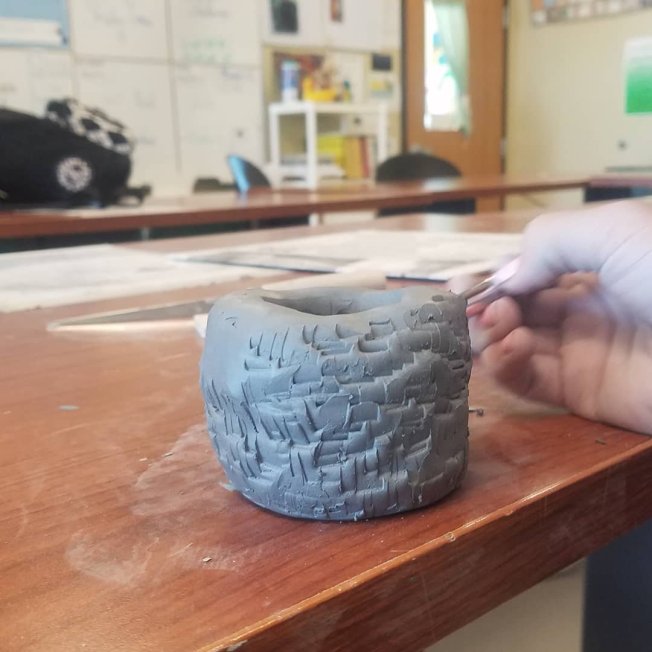I see it has been over 2 months since my last post. And, quite frankly, I’m not surprised. I had some ideas in the works for new posts on the exciting stuff and things happening in the Duck Art Room since January, but then Corona hit, and my spirits plummeted.
I tried with all I had in me to look the “new normal” in the eye and take it on. And by new normal, I mean remote teaching or distance learning or “homeschooling” 🙄🙄🙄. (Don’t get me started on how none of this is homeschooling. I know people that homeschool for a living, and this is not it folks. But I digress.) It was hard. I wanted to be the best teacher I could be, but in truth, I wanted to just paint and drink coffee and play with clay. And I’ve done all that. In fact, by the end of this, I will have a full kiln load of just stuff I made.
One week away from school turned to two weeks; then to three weeks. And now, I’m pretty sure we won’t be back this school year. And at this point, while I want to see all my kids more than anything, I don’t know how we could make the switch one more time with 7 weeks (in my district anyway) of school left — 3 of which we are definitely out for Shelter-In-Place orders.
My district has been remote teaching/distance learning for 3 weeks now. I feel it has all been one big trial and error session. My district finally came to a decision about grading and GPA and class rank–which for those of you who teach high school know that these things are currently important in the world of education and higher education. I won’t go into everything, but we are going to a pass/fail system for the second marking period of the 2019-20 school year. Grades will be assigned with “prominent emphasis on completion and effort”. So, that sounds good right. It sounds as about as equitable as they can get. We are trying very hard to make sure we can meet accommodations and reach students without internet and give grace to those struggling with home issues (siblings, work, etc.) that affect them being able to do school work. Could more be done? Probably. But I know we are trying.
What does this all have to do with Art and Teaching for Artistic Behavior and Duck Art? A lot actually. I said that my spirits had plummeted, and that included my spirit for facilitating meaningful art making situations for my students. Instead, I assigned what I felt was going to be the easiest thing for me to do. Currently, I have about 50-65% participation from my students–some do all of it, most pick and choose and turn in a thing here or a thing there. It made me sad to say the least. I was missing seeing my kids make and create and all those other things that go with being artists.
Earlier this week, I was looking at Facebook, like all who are at home do, and I finally clicked on my friend Melissa Purtee’s post about what she was doing remotely with her kids, and it sparked something in me. I was then reminded of a post another friend had put in the main TAB Facebook group about not forgetting our purpose as TAB teachers–those 3 main tenets of the philosophy. I knew I had to change what I was doing. I couldn’t sustain it anyway. So, I borrowed from Melissa, as she so graciously lets us do, and made a new website for my students–all of my students, no matter the level or the class type. It gives them choice. It lets them decided how to spend their time during the week–instead of a daily assignment, they know what they need to do for the week on Monday and can plan their schedule to meet their needs. It makes them think and decide and research and plan and all those behaviors we have been talking and learning about for months or years. I have full belief in my students and I am hoping that it is what is right for them, and for their situations. I hope they can see art making not as a thing they have to do, but they want to do–because the freedom is in their hands now.
I’ll leave you with this. I’m not sure how I feel about our “New Normal”. I just hope I am bringing a sense of comfort to my students thru art and choice as we navigate this together.


 I came into this semester in a different frame of mind. I realized in December that I needed to change what was happening in my art studio, what was happening with my students. I felt they weren’t getting the best out of our TAB studio. And, I knew it wasn’t really them, but it was me. I was doing what felt right last school year…what worked for last year’s students. I was doing what I thought I should be doing. I wasn’t really seeing what my kids were missing.
I came into this semester in a different frame of mind. I realized in December that I needed to change what was happening in my art studio, what was happening with my students. I felt they weren’t getting the best out of our TAB studio. And, I knew it wasn’t really them, but it was me. I was doing what felt right last school year…what worked for last year’s students. I was doing what I thought I should be doing. I wasn’t really seeing what my kids were missing.

























































